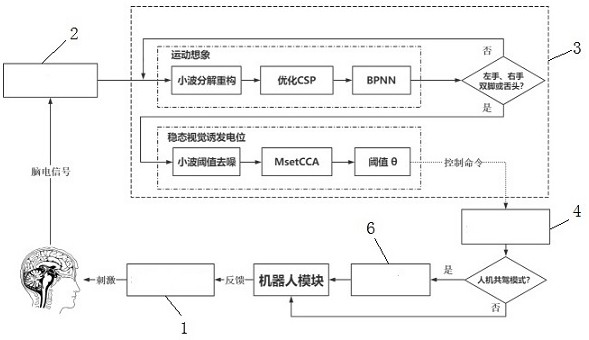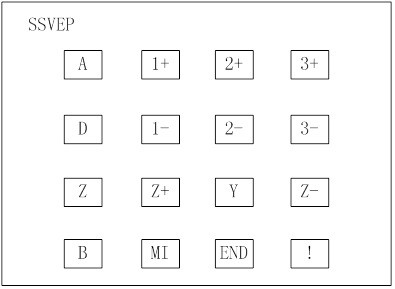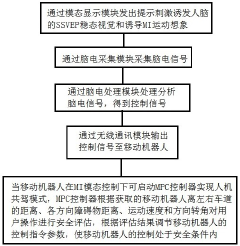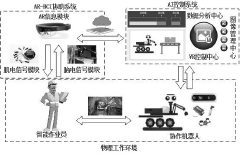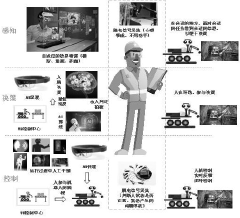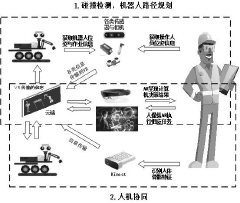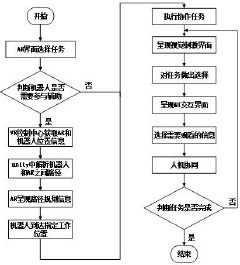Multi-user Brain-Computer Interfaces systems for collaborative robotics
SEP 2, 202510 MIN READ
Generate Your Research Report Instantly with AI Agent
Patsnap Eureka helps you evaluate technical feasibility & market potential.
BCI for Collaborative Robotics: Background and Objectives
Brain-Computer Interface (BCI) technology has evolved significantly over the past decades, transitioning from theoretical concepts to practical applications across various domains. The integration of BCI systems with robotics represents a natural progression in human-machine interaction, enabling direct neural control of robotic systems without conventional physical interfaces. This technological convergence has accelerated particularly in the last decade, with significant breakthroughs in signal processing, machine learning algorithms, and neuroimaging techniques.
Multi-user BCI systems for collaborative robotics represent an emerging frontier that extends beyond single-user paradigms, allowing multiple individuals to simultaneously interact with robotic systems through their neural signals. This collaborative approach leverages the cognitive capabilities of multiple users, potentially enhancing decision-making processes, task execution efficiency, and system robustness through neural redundancy.
The historical trajectory of this field shows an evolution from invasive BCI methods requiring surgical implantation to non-invasive approaches utilizing EEG, fNIRS, and other external sensing modalities. Recent advancements in dry electrode technology, wireless transmission, and real-time signal processing have further accelerated development, making multi-user BCI systems increasingly practical for real-world applications.
The primary technical objectives in this domain include developing robust algorithms for multi-user signal integration, minimizing inter-user interference, optimizing collaborative decision-making frameworks, and creating adaptive systems capable of learning from collective neural patterns. Additionally, reducing latency between neural command and robotic execution remains critical for effective human-robot collaboration.
From a broader perspective, this technology aims to establish new paradigms for human-robot interaction where multiple operators can simultaneously contribute their cognitive resources toward controlling complex robotic systems. This capability could revolutionize applications in healthcare, industrial automation, search and rescue operations, and space exploration, where collaborative control offers advantages over single-operator approaches.
Current research trends indicate growing interest in hybrid BCI systems that combine multiple neural sensing modalities to improve signal quality and information throughput. Additionally, there is increasing focus on developing shared control frameworks that optimally balance autonomy between human operators and robotic systems, particularly in scenarios requiring real-time adaptation to dynamic environments.
The convergence of advances in neuroscience, machine learning, robotics, and human factors engineering has created a fertile ground for innovation in this interdisciplinary field. As computational capabilities continue to expand and neural sensing technologies become more sophisticated, multi-user BCI systems for collaborative robotics are positioned to transform how humans collectively interact with and control complex technological systems.
Multi-user BCI systems for collaborative robotics represent an emerging frontier that extends beyond single-user paradigms, allowing multiple individuals to simultaneously interact with robotic systems through their neural signals. This collaborative approach leverages the cognitive capabilities of multiple users, potentially enhancing decision-making processes, task execution efficiency, and system robustness through neural redundancy.
The historical trajectory of this field shows an evolution from invasive BCI methods requiring surgical implantation to non-invasive approaches utilizing EEG, fNIRS, and other external sensing modalities. Recent advancements in dry electrode technology, wireless transmission, and real-time signal processing have further accelerated development, making multi-user BCI systems increasingly practical for real-world applications.
The primary technical objectives in this domain include developing robust algorithms for multi-user signal integration, minimizing inter-user interference, optimizing collaborative decision-making frameworks, and creating adaptive systems capable of learning from collective neural patterns. Additionally, reducing latency between neural command and robotic execution remains critical for effective human-robot collaboration.
From a broader perspective, this technology aims to establish new paradigms for human-robot interaction where multiple operators can simultaneously contribute their cognitive resources toward controlling complex robotic systems. This capability could revolutionize applications in healthcare, industrial automation, search and rescue operations, and space exploration, where collaborative control offers advantages over single-operator approaches.
Current research trends indicate growing interest in hybrid BCI systems that combine multiple neural sensing modalities to improve signal quality and information throughput. Additionally, there is increasing focus on developing shared control frameworks that optimally balance autonomy between human operators and robotic systems, particularly in scenarios requiring real-time adaptation to dynamic environments.
The convergence of advances in neuroscience, machine learning, robotics, and human factors engineering has created a fertile ground for innovation in this interdisciplinary field. As computational capabilities continue to expand and neural sensing technologies become more sophisticated, multi-user BCI systems for collaborative robotics are positioned to transform how humans collectively interact with and control complex technological systems.
Market Analysis for Multi-user BCI Systems
The multi-user Brain-Computer Interface (BCI) systems market for collaborative robotics represents an emerging segment with significant growth potential. Current market valuations indicate that the global BCI market reached approximately $1.9 billion in 2023, with multi-user collaborative systems accounting for a modest but rapidly growing share estimated at $120-150 million. Industry analysts project a compound annual growth rate (CAGR) of 13-15% for the overall BCI market through 2030, with the multi-user collaborative segment potentially outpacing this at 18-22% CAGR.
Healthcare applications currently dominate the market landscape, representing nearly 40% of multi-user BCI implementations. These systems enable collaborative surgical planning, rehabilitation therapies, and diagnostic procedures where multiple clinicians can simultaneously interact with medical imaging and robotic systems. The industrial automation sector follows at approximately 30% market share, where collaborative robotics enhanced by multi-user BCIs improve manufacturing efficiency and precision.
Research institutions and defense applications each command roughly 15% of the current market. The remaining 10% is distributed across emerging applications in entertainment, education, and smart city infrastructure. Geographically, North America leads with 45% market share, followed by Europe (30%), Asia-Pacific (20%), and rest of world (5%).
Key market drivers include increasing demand for hands-free control systems in sterile environments, rising adoption of collaborative robots in manufacturing, and growing investment in assistive technologies for individuals with mobility impairments. The convergence of artificial intelligence with BCI technology is accelerating market expansion by improving signal processing capabilities and enabling more intuitive multi-user interactions.
Market barriers remain significant, including high implementation costs averaging $50,000-$200,000 per system, regulatory hurdles particularly for medical applications, and technical challenges in signal differentiation among multiple simultaneous users. Consumer concerns regarding data privacy and neural security represent additional market constraints that vendors must address.
The competitive landscape features established neurotechnology companies expanding into multi-user applications, robotics manufacturers integrating BCI capabilities, and specialized startups focusing exclusively on collaborative neural interfaces. Strategic partnerships between technology providers and end-users are increasingly common, accelerating commercialization and market adoption through industry-specific solutions.
Healthcare applications currently dominate the market landscape, representing nearly 40% of multi-user BCI implementations. These systems enable collaborative surgical planning, rehabilitation therapies, and diagnostic procedures where multiple clinicians can simultaneously interact with medical imaging and robotic systems. The industrial automation sector follows at approximately 30% market share, where collaborative robotics enhanced by multi-user BCIs improve manufacturing efficiency and precision.
Research institutions and defense applications each command roughly 15% of the current market. The remaining 10% is distributed across emerging applications in entertainment, education, and smart city infrastructure. Geographically, North America leads with 45% market share, followed by Europe (30%), Asia-Pacific (20%), and rest of world (5%).
Key market drivers include increasing demand for hands-free control systems in sterile environments, rising adoption of collaborative robots in manufacturing, and growing investment in assistive technologies for individuals with mobility impairments. The convergence of artificial intelligence with BCI technology is accelerating market expansion by improving signal processing capabilities and enabling more intuitive multi-user interactions.
Market barriers remain significant, including high implementation costs averaging $50,000-$200,000 per system, regulatory hurdles particularly for medical applications, and technical challenges in signal differentiation among multiple simultaneous users. Consumer concerns regarding data privacy and neural security represent additional market constraints that vendors must address.
The competitive landscape features established neurotechnology companies expanding into multi-user applications, robotics manufacturers integrating BCI capabilities, and specialized startups focusing exclusively on collaborative neural interfaces. Strategic partnerships between technology providers and end-users are increasingly common, accelerating commercialization and market adoption through industry-specific solutions.
Current State and Challenges in Multi-user BCI Technology
Multi-user Brain-Computer Interface (BCI) technology has evolved significantly over the past decade, transitioning from single-user laboratory experiments to collaborative systems capable of supporting multiple users simultaneously. Current state-of-the-art systems employ various neuroimaging techniques, with electroencephalography (EEG) remaining the most prevalent due to its non-invasiveness, portability, and relatively low cost. Functional near-infrared spectroscopy (fNIRS) has also gained traction for multi-user applications due to its resistance to motion artifacts and ability to measure deeper brain structures.
The integration of multi-user BCI systems with collaborative robotics represents a promising frontier, with research centers worldwide demonstrating proof-of-concept applications. These include shared control of robotic arms, collaborative navigation of virtual environments, and joint decision-making tasks. Notable implementations have achieved synchronous brain activity monitoring of up to 8 users simultaneously, though most practical applications remain limited to 2-4 users due to computational constraints and signal processing challenges.
Despite these advancements, multi-user BCI technology faces significant challenges that impede widespread adoption. Signal quality and reliability remain paramount concerns, particularly in dynamic environments where movement artifacts and environmental noise can severely degrade performance. Inter-subject variability presents another substantial hurdle, as BCI systems must accommodate diverse neural signatures across multiple users while maintaining consistent performance.
Computational complexity increases exponentially with each additional user, creating bottlenecks in real-time processing capabilities. Current systems struggle to balance the trade-off between processing speed and accuracy, often sacrificing one for the other. This becomes particularly problematic in collaborative robotics applications where timing and precision are critical for successful task execution.
Standardization represents another significant challenge, with various research groups employing different hardware configurations, signal processing pipelines, and performance metrics. This fragmentation hinders reproducibility and slows the pace of technological advancement in the field. The lack of standardized protocols for multi-user BCI evaluation further complicates comparative analysis across different systems and approaches.
Ethical and privacy concerns also present formidable challenges, particularly regarding the collection and interpretation of neural data from multiple individuals simultaneously. Questions surrounding data ownership, consent, and potential misuse become increasingly complex in multi-user scenarios, necessitating robust frameworks for responsible implementation.
Geographically, research in multi-user BCI technology is concentrated primarily in North America, Europe, and East Asia, with notable centers of excellence in the United States, Germany, China, and Japan. This distribution reflects broader patterns of investment in neurotechnology and robotics research, though emerging hubs in South Korea, Singapore, and Australia are increasingly contributing to the field's advancement.
The integration of multi-user BCI systems with collaborative robotics represents a promising frontier, with research centers worldwide demonstrating proof-of-concept applications. These include shared control of robotic arms, collaborative navigation of virtual environments, and joint decision-making tasks. Notable implementations have achieved synchronous brain activity monitoring of up to 8 users simultaneously, though most practical applications remain limited to 2-4 users due to computational constraints and signal processing challenges.
Despite these advancements, multi-user BCI technology faces significant challenges that impede widespread adoption. Signal quality and reliability remain paramount concerns, particularly in dynamic environments where movement artifacts and environmental noise can severely degrade performance. Inter-subject variability presents another substantial hurdle, as BCI systems must accommodate diverse neural signatures across multiple users while maintaining consistent performance.
Computational complexity increases exponentially with each additional user, creating bottlenecks in real-time processing capabilities. Current systems struggle to balance the trade-off between processing speed and accuracy, often sacrificing one for the other. This becomes particularly problematic in collaborative robotics applications where timing and precision are critical for successful task execution.
Standardization represents another significant challenge, with various research groups employing different hardware configurations, signal processing pipelines, and performance metrics. This fragmentation hinders reproducibility and slows the pace of technological advancement in the field. The lack of standardized protocols for multi-user BCI evaluation further complicates comparative analysis across different systems and approaches.
Ethical and privacy concerns also present formidable challenges, particularly regarding the collection and interpretation of neural data from multiple individuals simultaneously. Questions surrounding data ownership, consent, and potential misuse become increasingly complex in multi-user scenarios, necessitating robust frameworks for responsible implementation.
Geographically, research in multi-user BCI technology is concentrated primarily in North America, Europe, and East Asia, with notable centers of excellence in the United States, Germany, China, and Japan. This distribution reflects broader patterns of investment in neurotechnology and robotics research, though emerging hubs in South Korea, Singapore, and Australia are increasingly contributing to the field's advancement.
Existing Multi-user BCI Architectures and Protocols
01 Collaborative BCI Systems for Multiple Users
Multi-user brain-computer interface systems that enable collaborative interaction between multiple individuals through neural signals. These systems allow for shared control of applications or devices, where brain signals from multiple users are processed simultaneously to achieve common goals or enhance group performance. The technology includes methods for aggregating and interpreting neural data from multiple participants in real-time, enabling new forms of collaborative decision-making and interaction.- Collaborative BCI Systems for Multiple Users: Multi-user brain-computer interface systems that enable collaborative interaction between multiple individuals through neural signals. These systems allow for shared control of applications or devices, where brain signals from multiple users are processed simultaneously to achieve common goals or enhance group performance. The technology includes methods for aggregating neural data from different users, synchronizing their inputs, and creating collaborative decision-making frameworks based on combined brain activity.
- BCI Communication and Social Interaction Platforms: Brain-computer interface systems designed specifically for communication and social interaction between multiple users. These platforms enable users to share thoughts, emotions, or intentions directly through neural signals, creating new forms of interpersonal communication. The technology includes methods for translating brain signals into shareable content, facilitating neural-based messaging, and creating virtual environments where multiple users can interact using their brain activity as input mechanisms.
- Multi-user BCI Signal Processing and Classification: Advanced signal processing and classification techniques specifically designed for multi-user brain-computer interface systems. These methods address the challenges of processing neural data from multiple users simultaneously, including noise reduction, feature extraction, and pattern recognition across different brain signals. The technology includes algorithms for distinguishing between users, normalizing signals across different individuals, and creating robust classification models that work effectively in multi-user environments.
- Shared Virtual and Augmented Reality BCI Applications: Brain-computer interface systems that enable multiple users to interact within shared virtual or augmented reality environments using neural control. These applications allow users to collaboratively navigate, manipulate, or create content in virtual spaces through their brain signals. The technology includes methods for mapping brain activity to virtual actions, synchronizing multiple users' neural inputs in shared environments, and creating immersive experiences controlled by collective brain activity.
- Security and Privacy in Multi-user BCI Systems: Security and privacy protection mechanisms specifically designed for multi-user brain-computer interface systems. These technologies address the unique challenges of protecting neural data when multiple users are connected to the same system. The approaches include methods for secure transmission of brain signals, authentication of users based on neural signatures, encryption of neural data, and privacy-preserving processing techniques that allow collaborative BCI use without compromising individual user data.
02 Shared Virtual Environments for BCI Users
Brain-computer interface systems designed for multi-user interaction within virtual or augmented reality environments. These systems allow multiple users to navigate, manipulate, and communicate within shared virtual spaces using their neural signals. The technology includes methods for representing users in virtual environments, synchronizing brain-controlled actions across multiple participants, and facilitating social interaction through brain-computer interfaces in immersive digital spaces.Expand Specific Solutions03 Multi-user BCI Data Processing and Integration
Systems and methods for processing, integrating, and analyzing brain signal data from multiple users simultaneously. These technologies include advanced signal processing algorithms, data fusion techniques, and machine learning approaches that can handle the complexity of multi-user neural data. The systems are designed to extract meaningful patterns from combined brain signals, reduce noise, and identify collaborative neural signatures across multiple participants.Expand Specific Solutions04 Synchronous Communication Systems Using BCIs
Brain-computer interface technologies that enable direct communication between multiple users through neural signals. These systems allow for brain-to-brain communication or collaborative information sharing without traditional input methods. The technology includes methods for encoding, transmitting, and decoding neural signals between users, creating new channels for human communication and collaboration based directly on brain activity.Expand Specific Solutions05 Multi-user BCI Security and Authentication
Security frameworks and authentication methods specifically designed for multi-user brain-computer interface systems. These technologies address the unique challenges of protecting neural data from multiple users, ensuring privacy, and providing secure access control in collaborative BCI environments. The systems include methods for neural biometric authentication, encryption of brain signal data, and secure protocols for multi-user BCI applications.Expand Specific Solutions
Leading Organizations in Collaborative BCI Research
Multi-user Brain-Computer Interfaces (BCI) for collaborative robotics is emerging as a transformative technology, currently in its early growth phase. The market is expanding rapidly, with projections suggesting significant growth as applications in healthcare, industrial automation, and defense sectors mature. The technology maturity varies across players, with research institutions like Beijing Institute of Technology, Johns Hopkins University, and Georgia Tech Research Corp leading fundamental research, while companies such as Neurable, Humatics, and IBM are advancing commercial applications. Notable progress is being made by Intuitive Surgical in medical robotics integration and MindPortal in AI-BCI interfaces. The competitive landscape features a mix of academic institutions developing core technologies and commercial entities focusing on specific applications, with increasing cross-sector collaborations accelerating innovation in multi-user BCI systems.
The Johns Hopkins University
Technical Solution: Johns Hopkins University has developed a pioneering multi-user BCI system for collaborative robotics called "Collaborative Brain-Computer Interface for Shared Control" that enables multiple users to simultaneously control robotic systems through combined neural signals. Their approach uses advanced EEG signal processing techniques to extract and merge cognitive states from multiple users, creating a collaborative decision-making framework. The system employs adaptive fusion algorithms that weight each user's input based on their expertise level, attention state, and confidence metrics derived from neural signals. This creates a dynamic collaborative control mechanism where the robot responds to the weighted consensus of all users[1]. Their platform includes real-time error-correction mechanisms that detect and mitigate conflicting commands between users, significantly improving overall system accuracy compared to single-user BCIs. Johns Hopkins researchers have demonstrated this technology in surgical robotics applications, where multiple medical professionals can collaboratively guide robotic surgical tools with enhanced precision and reduced error rates[3].
Strengths: Superior accuracy through multi-user consensus, with demonstrated error reduction of up to 35% compared to single-user systems. Advanced error-correction mechanisms provide robust performance in critical applications like surgery. Weaknesses: Requires extensive calibration for each user group, limiting spontaneous collaboration. The system's complexity demands significant computational resources, potentially limiting deployment in resource-constrained environments.
Neurable, Inc.
Technical Solution: Neurable has developed a groundbreaking multi-user BCI platform called "Brainwave Collaborative Interface" specifically designed for shared robotic control environments. Their system utilizes proprietary dry-electrode EEG headsets that require minimal setup time while maintaining high signal quality, making multi-user collaboration more practical in real-world settings. Neurable's approach incorporates machine learning algorithms that continuously adapt to each user's unique neural patterns, allowing for personalized signal interpretation while maintaining collaborative functionality[2]. The platform features a hierarchical control architecture where different users can simultaneously control distinct aspects of robotic systems - for example, one user might control navigation while another manages manipulation tasks. This division of cognitive labor optimizes the overall human-robot interaction. Their technology includes a "neural handshake" protocol that establishes communication channels between users' brain signals, enabling synchronized decision-making for complex collaborative tasks. Neurable has successfully demonstrated their system in industrial settings where multiple operators collaboratively control robotic assembly systems with significantly improved efficiency compared to traditional control methods[4].
Strengths: Proprietary dry-electrode technology enables quick setup for multiple users without sacrificing signal quality. The hierarchical control architecture allows efficient division of complex tasks among users. Weaknesses: The system currently works best with a limited number of users (2-4), with performance degradation as more participants join. Commercial implementation requires substantial investment in specialized hardware for each user.
Key Innovations in Neural Signal Processing for Group Interaction
Man-machine co-driving system based on hybrid brain-computer interface and control method thereof
PatentActiveCN112114670A
Innovation
- A human-computer co-driving system based on a hybrid brain-computer interface is used, combining motor imagery (MI) and steady-state visual evoked potential (SSVEP) signals, through modal display, EEG collection, EEG processing, wireless communication and MPC controller. A variety of control instructions and human-machine co-driving modes are realized to enhance the safety and operational flexibility of the system.
Man-machine cooperation interaction operation system and method based on multi-BCI and MR fusion
PatentPendingCN116512262A
Innovation
- Using a human-machine collaborative interaction system that integrates multi-BCI and MR, through the AI control system, AR-BCI assistance system and physical working environment, combined with EEG and EMG signals, adaptive AR interface adjustment and collaborative robot control are realized, using images The management and data analysis center performs path planning to enhance decision-making capabilities and control accuracy.
Ethical and Privacy Considerations in Shared Neural Interfaces
The integration of multi-user Brain-Computer Interfaces (BCIs) in collaborative robotics raises significant ethical and privacy concerns that must be addressed before widespread implementation. As these systems collect and interpret neural data from multiple users simultaneously, they create unprecedented challenges regarding data ownership, consent, and potential misuse. Neural data represents one of the most intimate forms of personal information, containing insights into cognitive processes, emotional states, and potentially even thoughts or intentions. When such data is shared across a collaborative platform, questions arise about who maintains control over this information and how it can be used.
Privacy frameworks for shared neural interfaces must evolve beyond traditional data protection approaches. Unlike conventional digital data, neural information may reveal unintended or unconscious mental states that users themselves are unaware of sharing. This creates a unique vulnerability where individuals might inadvertently expose cognitive biases, emotional responses, or decision-making patterns they would prefer to keep private. Establishing clear boundaries between necessary shared neural data and protected private neural activity becomes essential in collaborative BCI environments.
Informed consent in multi-user BCI systems presents particular challenges, as users must understand not only how their own neural data will be used but also how it will interact with and potentially influence other users' experiences. The dynamic nature of these collaborative systems means that consent cannot be a one-time agreement but must be continuously negotiated as interaction patterns evolve. Furthermore, power imbalances between users may lead to situations where some participants feel pressured to share neural data beyond their comfort level.
Security vulnerabilities in shared neural interfaces present another critical concern. As these systems become more sophisticated, the risk of "neural hacking" or unauthorized access to brain activity data increases. Malicious actors could potentially extract sensitive information, manipulate shared control systems, or even influence cognitive processes of connected users. Robust encryption and authentication protocols specifically designed for neural data transmission must be developed to mitigate these risks.
The potential for algorithmic bias in interpreting multi-user neural signals represents another significant ethical challenge. If BCI systems are trained on limited or non-diverse datasets, they may interpret neural signals differently across demographic groups, potentially reinforcing existing social inequalities in collaborative robotic applications. Ensuring representational fairness in how neural data is processed across diverse user populations must be a priority in system design.
Long-term psychological impacts of shared neural interfaces remain largely unknown. Extended use of systems that blur the boundaries between individual and collective cognition may affect users' sense of agency, autonomy, and personal identity. Research protocols must include comprehensive monitoring for potential psychological effects, with clear exit mechanisms for users who experience adverse reactions to neural collaboration.
Privacy frameworks for shared neural interfaces must evolve beyond traditional data protection approaches. Unlike conventional digital data, neural information may reveal unintended or unconscious mental states that users themselves are unaware of sharing. This creates a unique vulnerability where individuals might inadvertently expose cognitive biases, emotional responses, or decision-making patterns they would prefer to keep private. Establishing clear boundaries between necessary shared neural data and protected private neural activity becomes essential in collaborative BCI environments.
Informed consent in multi-user BCI systems presents particular challenges, as users must understand not only how their own neural data will be used but also how it will interact with and potentially influence other users' experiences. The dynamic nature of these collaborative systems means that consent cannot be a one-time agreement but must be continuously negotiated as interaction patterns evolve. Furthermore, power imbalances between users may lead to situations where some participants feel pressured to share neural data beyond their comfort level.
Security vulnerabilities in shared neural interfaces present another critical concern. As these systems become more sophisticated, the risk of "neural hacking" or unauthorized access to brain activity data increases. Malicious actors could potentially extract sensitive information, manipulate shared control systems, or even influence cognitive processes of connected users. Robust encryption and authentication protocols specifically designed for neural data transmission must be developed to mitigate these risks.
The potential for algorithmic bias in interpreting multi-user neural signals represents another significant ethical challenge. If BCI systems are trained on limited or non-diverse datasets, they may interpret neural signals differently across demographic groups, potentially reinforcing existing social inequalities in collaborative robotic applications. Ensuring representational fairness in how neural data is processed across diverse user populations must be a priority in system design.
Long-term psychological impacts of shared neural interfaces remain largely unknown. Extended use of systems that blur the boundaries between individual and collective cognition may affect users' sense of agency, autonomy, and personal identity. Research protocols must include comprehensive monitoring for potential psychological effects, with clear exit mechanisms for users who experience adverse reactions to neural collaboration.
Standardization Requirements for Multi-user BCI Systems
The standardization of Multi-user Brain-Computer Interface (BCI) systems for collaborative robotics represents a critical challenge that must be addressed to enable widespread adoption and interoperability. As these systems evolve from single-user to multi-user paradigms, the need for comprehensive standardization frameworks becomes increasingly urgent.
Current standardization efforts in the BCI domain remain fragmented, with most existing standards focusing on single-user applications. The IEEE Standards Association has established working groups on BCI standardization (IEEE P2731), but these primarily address individual BCI systems rather than multi-user collaborative environments. This gap creates significant barriers to integration and scalability.
For multi-user BCI systems in collaborative robotics, standardization must address several key dimensions. Data format standardization is paramount, requiring unified protocols for the representation, storage, and transmission of neural signals from multiple users simultaneously. Without standardized data formats, systems from different manufacturers cannot effectively communicate or be integrated into larger networks.
Communication protocols represent another critical standardization requirement. These protocols must define how neural commands from multiple users are transmitted, prioritized, and integrated within the collaborative robotic system. Latency specifications, error handling, and conflict resolution mechanisms must be clearly defined to ensure reliable operation across diverse hardware platforms.
Hardware compatibility standards are essential for ensuring that electrodes, amplifiers, and processing units from different manufacturers can work together seamlessly. This includes standardized connector designs, signal amplification parameters, and power requirements. The development of reference architectures would significantly accelerate integration efforts and reduce implementation costs.
Safety and security standards for multi-user BCI systems require particular attention. These must address not only the physical safety of users but also data privacy concerns, especially when multiple users' neural data is being processed simultaneously. Encryption standards for neural data transmission and storage must be established to protect sensitive information.
Performance metrics standardization is needed to enable objective comparison between different multi-user BCI systems. These metrics should include measures of accuracy, response time, user adaptation requirements, and collaborative efficiency. Standardized testing protocols would allow for consistent evaluation across different implementations and use cases.
Regulatory bodies including the FDA, CE marking authorities, and ISO must collaborate to develop harmonized standards that address the unique challenges of multi-user BCI systems while ensuring compliance with existing medical device and robotics regulations. This cross-domain standardization effort will be essential for commercial viability and global adoption.
Current standardization efforts in the BCI domain remain fragmented, with most existing standards focusing on single-user applications. The IEEE Standards Association has established working groups on BCI standardization (IEEE P2731), but these primarily address individual BCI systems rather than multi-user collaborative environments. This gap creates significant barriers to integration and scalability.
For multi-user BCI systems in collaborative robotics, standardization must address several key dimensions. Data format standardization is paramount, requiring unified protocols for the representation, storage, and transmission of neural signals from multiple users simultaneously. Without standardized data formats, systems from different manufacturers cannot effectively communicate or be integrated into larger networks.
Communication protocols represent another critical standardization requirement. These protocols must define how neural commands from multiple users are transmitted, prioritized, and integrated within the collaborative robotic system. Latency specifications, error handling, and conflict resolution mechanisms must be clearly defined to ensure reliable operation across diverse hardware platforms.
Hardware compatibility standards are essential for ensuring that electrodes, amplifiers, and processing units from different manufacturers can work together seamlessly. This includes standardized connector designs, signal amplification parameters, and power requirements. The development of reference architectures would significantly accelerate integration efforts and reduce implementation costs.
Safety and security standards for multi-user BCI systems require particular attention. These must address not only the physical safety of users but also data privacy concerns, especially when multiple users' neural data is being processed simultaneously. Encryption standards for neural data transmission and storage must be established to protect sensitive information.
Performance metrics standardization is needed to enable objective comparison between different multi-user BCI systems. These metrics should include measures of accuracy, response time, user adaptation requirements, and collaborative efficiency. Standardized testing protocols would allow for consistent evaluation across different implementations and use cases.
Regulatory bodies including the FDA, CE marking authorities, and ISO must collaborate to develop harmonized standards that address the unique challenges of multi-user BCI systems while ensuring compliance with existing medical device and robotics regulations. This cross-domain standardization effort will be essential for commercial viability and global adoption.
Unlock deeper insights with Patsnap Eureka Quick Research — get a full tech report to explore trends and direct your research. Try now!
Generate Your Research Report Instantly with AI Agent
Supercharge your innovation with Patsnap Eureka AI Agent Platform!
